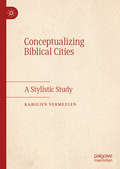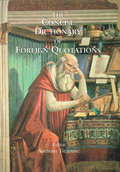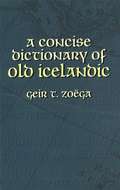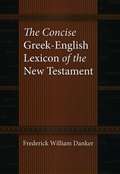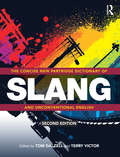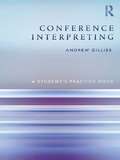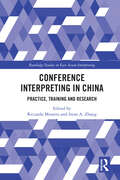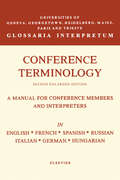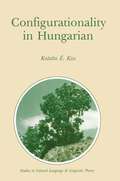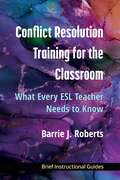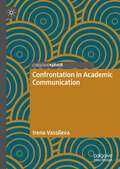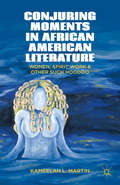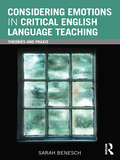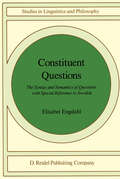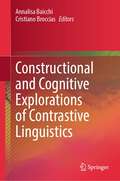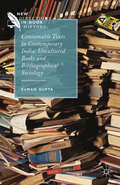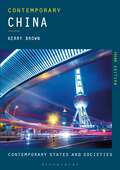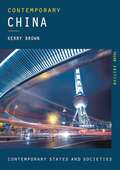- Table View
- List View
Conceptualizing Biblical Cities: A Stylistic Study
by Karolien VermeulenThis book offers a comprehensive treatment of the city image in the Hebrew Bible, with specific attention to stylistics. By engaging with spatial theory (Lefebvre 1974, Soja 1996), the author develops a new framework to analyse the concept of ‘city’, arguing that a set of conceptual images defines the Biblical Hebrew city, each of them constructed using the same linguistic toolkit. Contrary to previous studies, the book shows that biblical cities are not necessarily evil or female. In addition, there is no substantial difference between the metaphorical images used for Jerusalem and those used for other cities. This book will be of interest to students and scholars of stylistics, urban studies, critical-spatial theory and biblical studies (especially Biblical Hebrew).
Concise Dictionary of Foreign Quotations
by Anthony LejeuneHere is the answer for anyone who comes across a foreign-language quotation in a newspaper article or a book and isn't quite sure what it means. Here are famous sayings, in five European languages--Latin, French, German, Italian, and Spanish--accompanied by their translations into English and cross-indexed for easy reference. Just what did Mussolini say about making the trains run on time? Did Marie-Antoinette really tell the poor to eat cake? Concise Dictionary of Foreign Quotations includes more than 3,000 entries, chosen by five editors, each one widely read in the language concerned. The majority of entries were included because they are familiar, those an English reader would be most likely to encounter. Literary quotations, political quotations, poetic thoughts, pungent comments, polished epigrams, shrewd perceptions--by everyone from Cicero to Sartre, from Michelangelo to Picasso.
Concise Dictionary of Foreign Quotations: Latin, French, Spanish, German And Italian
by Anthony LejeuneHere is the answer for anyone who comes across a foreign-language quotation in a newspaper article or a book and isn't quite sure what it means. Here are famous sayings, in five European languages--Latin, French, German, Italian, and Spanish--accompanied by their translations into English and cross-indexed for easy reference. Just what did Mussolini say about making the trains run on time? Did Marie-Antoinette really tell the poor to eat cake? Concise Dictionary of Foreign Quotations includes more than 3,000 entries, chosen by five editors, each one widely read in the language concerned. The majority of entries were included because they are familiar, those an English reader would be most likely to encounter. Literary quotations, political quotations, poetic thoughts, pungent comments, polished epigrams, shrewd perceptions--by everyone from Cicero to Sartre, from Michelangelo to Picasso.
A Concise Dictionary of Old Icelandic
by Geir T. ZoëgaModern Icelandic is closer to the speech patterns of the Middle Ages than any living European language. Thus, a knowledge of Icelandic is highly relevant to the study of English history. This volume, one of the most complete available, will be indispensable to scholars of medieval Icelandic and English culture and history.
The Concise Greek-English Lexicon of the New Testament
by Frederick William DankerFrederick William Danker, a world-renowned scholar of New Testament Greek, is widely acclaimed for his 2000 revision of Walter Bauer’s A Greek-English Lexicon of the New Testament and Other Early Christian Literature. With more than a quarter of a million copies in print, it is considered the finest dictionary of its kind. Danker’s Concise Greek-English Lexicon of the New Testament will prove to be similarly invaluable to ministers, seminarians, translators, and students of biblical Greek. Unlike other lexica of the Greek New Testament, which give only brief glosses for headwords, The Concise Greek-English Lexicon offers extended definitions or explanations in idiomatic English for all Greek terms. Each entry includes basic etymological information, short renderings, information on usage, and plentiful biblical references. Greek terms that could have different English definitions, depending on context, are thoughtfully keyed to the appropriate passages. An overarching aim of The Concise Greek-English Lexicon is to assist the reader in recognizing the broad linguistic and cultural context for New Testament usage of words. The Concise Greek-English Lexicon retains all the acclaimed features of A Greek-English Lexicon in a succinct and affordable handbook, perfect for specialists and nonspecialists alike.
The Concise Greek-English Lexicon of the New Testament
by Frederick William DankerFrederick William Danker, a world-renowned scholar of New Testament Greek, is widely acclaimed for his 2000 revision of Walter Bauer’s A Greek-English Lexicon of the New Testament and Other Early Christian Literature. With more than a quarter of a million copies in print, it is considered the finest dictionary of its kind. Danker’s Concise Greek-English Lexicon of the New Testament will prove to be similarly invaluable to ministers, seminarians, translators, and students of biblical Greek. Unlike other lexica of the Greek New Testament, which give only brief glosses for headwords, The Concise Greek-English Lexicon offers extended definitions or explanations in idiomatic English for all Greek terms. Each entry includes basic etymological information, short renderings, information on usage, and plentiful biblical references. Greek terms that could have different English definitions, depending on context, are thoughtfully keyed to the appropriate passages. An overarching aim of The Concise Greek-English Lexicon is to assist the reader in recognizing the broad linguistic and cultural context for New Testament usage of words. The Concise Greek-English Lexicon retains all the acclaimed features of A Greek-English Lexicon in a succinct and affordable handbook, perfect for specialists and nonspecialists alike.
The Concise New Partridge Dictionary of Slang and Unconventional English
by Tom Dalzell Terry VictorThe Concise New Partridge Dictionary of Slang and Unconventional English presents all the slang terms from The New Partridge Dictionary of Slang and Unconventional English in a single volume. Containing over 60,000 entries, this concise new edition of the authoritative work details the slang and unconventional English of from around the English-speaking world since 1945, and through the first decade of the new millennium, with the same thorough, intense, and lively scholarship that characterized Partridge’s own work. Unique, exciting and, at times, hilariously shocking, key features include: unprecedented coverage of World English, with equal prominence given to American and British English slang, and entries included from Australia, New Zealand, Canada, India, South Africa, Ireland, and the Caribbean emphasis on post-World War II slang and unconventional English dating information for each headword in the tradition of Partridge, commentary on the term’s origins and meaning. New to this second edition: a new preface noting slang trends of the last eight years over 1,000 new entries from the US, UK and Australia, reflecting important developments in language and culture new terms from the language of social networking from a range of digital communities including texting, blogs, Facebook, Twitter and online forums many entries now revised to include new dating and new glosses, ensuring maximum accuracy of content. The Concise New Partridge Dictionary of Slang and Unconventional English is a spectacular resource infused with humour and learning – it’s rude, it’s delightful, and it’s a prize for anyone with a love of language.
The Concise New Partridge Dictionary of Slang and Unconventional English
by Tom Dalzell Terry VictorThe Concise New Partridge Dictionary of Slang and Unconventional English presents all the slang terms from The New Partridge Dictionary of Slang and Unconventional English in a single volume. Containing over 60,000 entries, this concise new edition of the authoritative work details the slang and unconventional English of from around the English-speaking world since 1945, and through the first decade of the new millennium, with the same thorough, intense, and lively scholarship that characterized Partridge’s own work. Unique, exciting and, at times, hilariously shocking, key features include: unprecedented coverage of World English, with equal prominence given to American and British English slang, and entries included from Australia, New Zealand, Canada, India, South Africa, Ireland, and the Caribbean emphasis on post-World War II slang and unconventional English dating information for each headword in the tradition of Partridge, commentary on the term’s origins and meaning. New to this second edition: a new preface noting slang trends of the last eight years over 1,000 new entries from the US, UK and Australia, reflecting important developments in language and culture new terms from the language of social networking from a range of digital communities including texting, blogs, Facebook, Twitter and online forums many entries now revised to include new dating and new glosses, ensuring maximum accuracy of content. The Concise New Partridge Dictionary of Slang and Unconventional English is a spectacular resource infused with humour and learning – it’s rude, it’s delightful, and it’s a prize for anyone with a love of language.
Conference Interpreting: A Student’s Practice Book
by Andrew GilliesConference Interpreting: A Student’s Practice Book brings together a comprehensive compilation of tried and tested practical exercises which hone the sub-skills that make up successful conference interpreting Unique in its exclusively practical focus, Conference Interpreting: A Student’s Practice Book, serves as a reference for students and teachers seeking to solve specific interpreting-related difficulties. By breaking down the necessary skills and linking these to the most relevant and effective exercises students can target their areas of weakness and work more efficiently towards greater interpreting competence. Split into four parts, this Practice Book includes a detailed introduction offering general principles for effective practice drawn from the author’s own extensive experience as an interpreter and interpreter-trainer. The second ‘language’ section covers language enhancement at this very high level, an area that standard language courses and textbooks are unable to deal with. The last two sections cover the key sub-skills needed to effectively handle the two components of conference interpreting; simultaneous and consecutive interpreting. Conference Interpreting: A Student’s Practice Book is non language-specific and as such is an essential resource for all interpreting students regardless of their language combination.
Conference Interpreting: A Student’s Practice Book
by Andrew GilliesConference Interpreting: A Student’s Practice Book brings together a comprehensive compilation of tried and tested practical exercises which hone the sub-skills that make up successful conference interpreting Unique in its exclusively practical focus, Conference Interpreting: A Student’s Practice Book, serves as a reference for students and teachers seeking to solve specific interpreting-related difficulties. By breaking down the necessary skills and linking these to the most relevant and effective exercises students can target their areas of weakness and work more efficiently towards greater interpreting competence. Split into four parts, this Practice Book includes a detailed introduction offering general principles for effective practice drawn from the author’s own extensive experience as an interpreter and interpreter-trainer. The second ‘language’ section covers language enhancement at this very high level, an area that standard language courses and textbooks are unable to deal with. The last two sections cover the key sub-skills needed to effectively handle the two components of conference interpreting; simultaneous and consecutive interpreting. Conference Interpreting: A Student’s Practice Book is non language-specific and as such is an essential resource for all interpreting students regardless of their language combination.
Conference Interpreting in China: Practice, Training and Research (Routledge Studies in East Asian Interpreting)
by Riccardo Moratto Irene A. ZhangIn this landmark project, Moratto and Zhang evaluate how conference interpreting developed as a profession in China, and the directions in which it is heading. Bringing together perspectives from leading researchers in the field, Moratto and Zhang present a thematically organized analysis of the trajectory of professional conference interpreting in China. This includes discussion of the pedagogies used both currently and historically, the professionalization of interpreter education, and future prospects for virtual reality, multimodal conferences, and artificial intelligence. Taken as a whole, the contributors present a rich and detailed picture of the development of conference interpreting in China since 1979, its status today, and how it is likely to develop in the coming decades. An essential resource for scholars and students of conference interpreting in China, alongside its sister volume, The Pioneers of Chinese Interpreting: Insiders’ Accounts on the Rise of a Profession.
Conference Interpreting in China: Practice, Training and Research (Routledge Studies in East Asian Interpreting)
In this landmark project, Moratto and Zhang evaluate how conference interpreting developed as a profession in China, and the directions in which it is heading. Bringing together perspectives from leading researchers in the field, Moratto and Zhang present a thematically organized analysis of the trajectory of professional conference interpreting in China. This includes discussion of the pedagogies used both currently and historically, the professionalization of interpreter education, and future prospects for virtual reality, multimodal conferences, and artificial intelligence. Taken as a whole, the contributors present a rich and detailed picture of the development of conference interpreting in China since 1979, its status today, and how it is likely to develop in the coming decades. An essential resource for scholars and students of conference interpreting in China, alongside its sister volume, The Pioneers of Chinese Interpreting: Insiders’ Accounts on the Rise of a Profession.
Conference Terminology: In English, French, Spanish, Russian, Italian, German and Hungarian (Glossaria Interpretum)
by J. HerbertAnalysis of the great demand for this work over a number of years has revealed that conference participants and interpreters, for whom the manual was primarily intended, are by no means alone in appreciating the usefulness and reliability of this unique publication. Whilst the editor has taken account of a small number of linguistic refinements and preferences in recent conference usage and has carefully reviewed the original material, he has seen no reason to enlarge the scope or alter the format of the previous edition - both these features of an essentially concise handbook having clearly met the practical requirements of its many users. For this edition the number of languages has been increased to include Hungarian.
Configurationality in Hungarian (Studies in Natural Language and Linguistic Theory #3)
by Katalin E. KissThe purpose of this book is to argue for the claim that Hungarian sentence structure consists of a non-configurational propositional component, preceded by configurationally determined operator positions. In the course of this, various descriptive issues of Hungarian syntax will be analyzed, and various theoretical questions concerning the existence and nature of non configurational languages will be addressed. The descriptive problems to be examined in Chapters 2 and 3 center around the word order of Hungarian sentences. Chapter 2 identifies an invariant structure in the apparently freely permutable Hungarian sentence, pointing out systematic correspondences between the structural position, interpre tation, and stressing and intonation of the different constituents. Chapter 3 analyzes the word order phenomenon traditionally called 'sentence inter- I twining' of complex sentences, and shows that the term, in fact, covers two different constructions (a structure resulting from operator movement, and a base generated pattern) with differences in constituent order, operator scope and V-object agreement. Chapter 4 deals interpretation, case assignment, with the coreference possibilities of reflexives, reciprocals, personal pro nouns, and lexical NPs. Finally, Chapter 5 assigns structures to the two major sentence types containing an infinitive. It analyzes infinitives with an AGR marker and a lexical subject, focusing on the problem of case assignment to the subject, as well as subject control constructions, accounting for their often paradoxical, simultaneously mono- and biclausal behaviour in respect to word order, operator scope, and V-object agreement.
Conflict Resolution Training for the Classroom: What Every ESL Teacher Needs to Know
by Barrie RobertsESL instructors without a background in conflict resolution (CR) who teach intermediate to advanced courses at colleges, universities, or in Intensive English Programs, may want to provide students with valuable negotiation and mediation skills. Author Barrie J. Roberts is an experienced ESL teacher, lawyer, mediator, and Alternative Dispute Resolution (ADR) Administrator for southern California Superior Courts. In this book, she draws upon her experience using these activities in a variety of ESL settings and courses with students from all over the world to inspire other ESL teachers to add CR approaches to their activities, lessons, and courses. Following an introduction to conflict resolution, Conflict Resolution Training for the Classroom shows how much of the teaching of CR is similar to teaching ESL. It outlines ways to apply negotiation and mediation to ESL activities, how to prevent and resolve conflicts, how to use specific types of role-plays to address conflicts, and how to design successful activities. The book also includes a list of resources and sample syllabi.
Conflict Resolution Training for the Classroom: What Every ESL Teacher Needs to Know
by Barrie RobertsESL instructors without a background in conflict resolution (CR) who teach intermediate to advanced courses at colleges, universities, or in Intensive English Programs, may want to provide students with valuable negotiation and mediation skills. Author Barrie J. Roberts is an experienced ESL teacher, lawyer, mediator, and Alternative Dispute Resolution (ADR) Administrator for southern California Superior Courts. In this book, she draws upon her experience using these activities in a variety of ESL settings and courses with students from all over the world to inspire other ESL teachers to add CR approaches to their activities, lessons, and courses. Following an introduction to conflict resolution, Conflict Resolution Training for the Classroom shows how much of the teaching of CR is similar to teaching ESL. It outlines ways to apply negotiation and mediation to ESL activities, how to prevent and resolve conflicts, how to use specific types of role-plays to address conflicts, and how to design successful activities. The book also includes a list of resources and sample syllabi.
Confrontation in Academic Communication
by Irena VassilevaThis book examines the argumentation strategies employed by linguists in voicing criticism, looks for explanations for confrontation in academic discourse, and evaluates the positive and/or negative effects it has on international academic communication. Issues such as the role of intertextuality, cross-cultural variations, and the notion of “academic discourse community” are also touched upon. Special attention is paid to the modern developments in contrastive rhetoric studies, as well as to the controversial issue of the use of context-based versus corpus-based methods. The corpus under investigation consists of academic book reviews in English and German with a clearly stated negative character, as well as a series of publications in English interrelated by the fact that they discuss a common group of problems but from two fully confrontative points of view. They illustrate what has been called an “academic war”. Some related theoretical issues are also discussed, including the role of evaluation in academic communication, the relationship between criticism, critique, negative evaluation, and confrontation in academic communication, as well as the importance of culture, discipline culture, and communities of practice. The contrastive discourse analysis demonstrates differences between English and German in terms of the rhetorical strategies employed by review writers to express criticism. The book will be of interest to researchers in the fields of academic communication and rhetorics, as well as teachers in English/German for academic purposes.
Conjuring Moments in African American Literature: Women, Spirit Work, and Other Such Hoodoo
by K. Samuel Kameelah L. MartinThis book engages the ways African American authors have shifted, recycled, and reinvented the conjure woman in fiction. Kameelah Martin Samuel traces her presence and function in twentieth-century literature through historical records, oral histories, blues music, and collections of African American folklore.
Considering Emotions in Critical English Language Teaching: Theories and Praxis
by Sarah BeneschGroundbreaking in the ways it makes new connections among emotion, critical theory, and pedagogy, this book explores the role of students’ and teachers’ emotions in college instruction, illuminating key literacy and identity issues faced by immigrant students learning English in postsecondary institutions. Offering a rich blend of, and interplay between, theory and practice, it asks: How have emotions and affect been theorized from a critical perspective, and how might these theories be applied to English language teaching and learning? What do complex and shifting emotions, such as hope, disappointment, indignation, and compassion, have to do with English language teaching and learning in the neoliberal context in public universities? How might attention to emotions lead to deeper understanding of classroom interactions and more satisfying educational experiences for English language teachers and students? These questions are addressed not just theoretically, but also practically with examples from college classes of assigned readings, student writing, and classroom talk in which various emotions came into play. Thought-provoking, accessible, and useful, this is a must-read book for scholars, students, and teachers in the field of English language teaching.
Considering Emotions in Critical English Language Teaching: Theories and Praxis
by Sarah BeneschGroundbreaking in the ways it makes new connections among emotion, critical theory, and pedagogy, this book explores the role of students’ and teachers’ emotions in college instruction, illuminating key literacy and identity issues faced by immigrant students learning English in postsecondary institutions. Offering a rich blend of, and interplay between, theory and practice, it asks: How have emotions and affect been theorized from a critical perspective, and how might these theories be applied to English language teaching and learning? What do complex and shifting emotions, such as hope, disappointment, indignation, and compassion, have to do with English language teaching and learning in the neoliberal context in public universities? How might attention to emotions lead to deeper understanding of classroom interactions and more satisfying educational experiences for English language teachers and students? These questions are addressed not just theoretically, but also practically with examples from college classes of assigned readings, student writing, and classroom talk in which various emotions came into play. Thought-provoking, accessible, and useful, this is a must-read book for scholars, students, and teachers in the field of English language teaching.
Constituent Questions: The Syntax and Semantics of Questions with Special Reference to Swedish (Studies in Linguistics and Philosophy #27)
by E. EngdahlConstructional and Cognitive Explorations of Contrastive Linguistics
by Annalisa Baicchi Cristiano BrocciasThis book approaches the field of contrastive linguistics from a comparative and robust perspective that combines the tenets of construction grammar and cognitive linguistics. In doing so, it shows how their integration can help to successfully enhance research on contrastivity, by means of updated theoretical frameworks and applied methodologies that combine language and thought. It compares ten different languages and offers analyses of constructions at all levels of the linguistic organization, identifying the cognitive motivations that instantiate the linguistic data retrieved from corpora. Relevant to both cognitive and non-cognitive linguists interested in variation and contrastive approaches, as well as graduate students in these areas, this book makes a significant contribution to existing work on the various types of constructional and discourse-based phenomena in modern languages.
Consumable Texts in Contemporary India: Uncultured Books and Bibliographical Sociology (New Directions in Book History)
by S. GuptaThrough what he terms "bibliographical sociology", Suman Gupta explores the presence of English-language publications in the contemporary Indian context – their productions, circulations and readerships – to understand current social trends.
Contemporary China (Contemporary States and Societies)
by Kerry BrownThe third edition of this concise core textbook offers students a comprehensive introduction to the politics, economy, culture and society of modern China, while grounding all of these areas in the context of China’s recent history in the nineteenth and twentieth centuries. Fully up to date, this accessible text examines the key developments that are taking place in China and that are shaping its place in the world today, from relations with Trump’s United States and post-Brexit Britain, to the use of the internet to crack down on dissent and the establishment of ‘Xi Jinping thought’ at the 19th Party Congress. Authored by a highly-regarded expert on the topic, this is the essential guide to a country that is no longer just emerging but one which has, in many respects, already emerged as one of the leading powers of the twenty-first century.The book is an ideal introductory text for undergraduate and postgraduate courses on China Studies and Contemporary China, regardless of whether students approach the topic from a political, historical, sociological, cultural or geographical viewpoint. It can also be used on modules focussing more specifically on Chinese Politics, Chinese History or Chinese Society.
Contemporary China (Contemporary States and Societies)
by Kerry BrownThe third edition of this concise core textbook offers students a comprehensive introduction to the politics, economy, culture and society of modern China, while grounding all of these areas in the context of China's recent history in the 19th and 20th centuries. Fully up to date, this accessible text examines the key developments that are taking place in China and that are shaping its place in the world today, from relations with Trump's United States and post-Brexit Britain, to the use of the internet to crack down on dissent and the establishment of 'Xi Jinping thought' at the 19th Party Congress. Authored by a highly-regarded expert on the topic, this is the essential guide to a country that is no longer just emerging but one which has, in many respects, already emerged as one of the leading powers of the 21st century.The book is an ideal introductory text for undergraduate and postgraduate courses on China studies and contemporary China, regardless of whether students approach the topic from a political, historical, sociological, cultural or geographical viewpoint. It can also be used on modules focussing more specifically on Chinese politics, Chinese history or Chinese society.New to this Edition:- Fully revised and updated throughout, including discussions of Chinese-US relations in the era of Trump, the 2017 19th National Congress of the Communist Party of China, and descriptions of the newest high-ranking figures in Chinese politics- New boxed features highlighting important issues and organisations, including the status of women in China, the telecoms company Huawei, and the on-going conflict over the South and East China Sea- References to the most recent research in the field, along with new recommendations for further reading for each chapter
